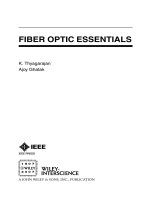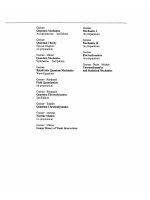elliot, b. (2002). fiber optic cabling (2nd ed.)
Bạn đang xem bản rút gọn của tài liệu. Xem và tải ngay bản đầy đủ của tài liệu tại đây (3.31 MB, 334 trang )
Fibre Optic CablingSecond Edition
Barry Elliott
Mike Gilmore
Fiber Optic Cabling
OXFORD AUCKLAND BOSTON JOHANNESBURG MELBOURNE NEW DELHI
Newnes
An imprint of Butterworth-Heinemann
Linacre House, Jordan Hill, Oxford OX2 8DP
225 Wildwood Avenue, Woburn, MA 01801-2041
A division of Reed Educational and Professional Publishing Ltd
A member of the Reed Elsevier plc group
First published 1991
Second edition 2002
© Mike Gilmore and Barry Elliott 2002
All rights reserved. No part of this publication may be reproduced in
any material form (including photocopying or storing in any medium by
electronic means and whether or not transiently or incidentally to some
other use of this publication) without the written permission of the
copyright holder except in accordance with the provisions of the
Copyright, Designs and Patents Act 1988 or under the terms of a
licence issued by the Copyright Licensing Agency Ltd, 90 Tottenham
Court Road, London, England W1P 0LP. Applications for the copyright
holder’s written permission to reproduce any part of this publication
should be addressed to the publishers
British Library Cataloguing in Publication Data
A catalogue record for this book is available from the British Library
ISBN 0 7506 5013 3
Composition by Scribe Design, Gillingham, Kent, UK
Printed and bound in Great Britain
Preface
Abbreviations
Safety statement
Cabling as an operating system
1 Fiber optic communications and the
data cabling revolution 1
Communications cabling and its role 2
Fiber optics and the cabling market 3
Fiber optic cabling as an operating system 7
The economics of fiber optic cabling 9
2 Optical fiber theory 2
Basic fiber parameters 2
Refractive index 12
Laws of reflection and refraction 15
Optical fiber and total inter nal reflection 18
Optical fiber constr uction and definitions 20
The ideal fiber 21
Light acceptance and numerical aper ture 22
Light loss and attenuation 24
Intrinsic loss mechanisms 24
Modal distribution and fiber attenuation 27
Extrinsic loss mechanisms 28
Impact of numerical aper ture on
attenuation 31
Operational wavelength windows 31
Bandwidth 31
Step index and graded index fibers 34
Modal conversion and its effect upon
bandwidth 36
Single mode transmission in optical fiber 39
Bandwidth specifications for optical fiber 45
System design, bandwidth utilization and
fiber geometries 46
Optical fiber geometries 47
The new family of single mode fiber 48
Plastic optical fiber 52
3 Optical fiber production techniques
Manufacturing techniques
Preform manufacture 55
Stepped index fiber preforms 55
All-silica fiber preforms 56
Fiber manufacture from preforms 63
Fiber compatibility 66
Clad silica fibers 66
Plastic optical fiber 67
Radiation hardness 68
Primary coating processes 70
4 Optical fiber connection theory and
basic techniques
Connection techniques
Connection categories 73
Insertion loss 73
Basic parametric mismatch 74
Fusion splice joints 78
Mechanical alignment 79
Joint loss, fiber geometry and preparation 84
Return loss 84
5 Practical aspects of connection
technology
Alignment techniques within joints
The joint and its specification 90
Inser tion loss and component
specifications 91
The introduction of optical fiber within joint
mechanisms 95
Joint mechanisms: relative cladding
diameter alignment 98
Joint mechanisms: absolute cladding
diameter alignment 100
6 Connectors and joints, alternatives
and applications
Splice joints 105
Demountable connectors 110
Standards and optical connectors 121
Termination: the attachment of a fiber optic
connector to a cable 124
Termination as an installation technique 127
7 Fiber optic cables
Basic cabling elements
Cabling requirements and designs 134
Fiber optic cable design definitions 135
Inter-building (external) cables 138
Intra-building (internal) cables 141
Fiber optic cables and optomechanical
stresses 143
User-friendly cable designs 147
The economics of optical fiber cable
design 147
8 Optical fiber highways
Optical fiber installations: definitions
The optical fiber highway 154
Optical fiber highway design 156
9 Optical fiber highway design
Nodal design 168
Ser vice needs 172
Optical budget 176
Bandwidth requirements 185
Fiber geometry choices within the highway
design 189
10 Component choice
Fiber optic cable and cable assemblies
Connectors 199
Splice components 200
Termination enclosures 201
11 Specification definition
T echnical ground r ules
Operational requirement 206
Design proposal 211
Optical specification 214
Contractual aspects of the specification
agreement 215
12 Acceptance test methods
Fixed cables
Air-blown fiber testing 229
Cable assembly acceptance testing 229
Direct termination during installation and its
effect upon quality assurance 239
Termination enclosures 239
Pre-installed cabling 240
Short-range systems and test philosophies 240
13 Installation practice
Transmission equipment and the overall
contract requirement 243
The role of the installer 244
The typical installation 244
Contract management 245
Installation programme 248
Termination practices 253
14 Final acceptance testing
General inspection
Optical performance testing 259
Overall span attenuation measurement 262
Optical time domain reflectometer testing
of installed spans 267
15 Documentation
Contract documentation
Technical documentation 275
The function of final highway
documentation 283
Internationalstandards concerning project
documentation 283
16 Repair and maintenance
Repair
Maintenance 289
17 Case study
Preliminary ideas
Network requirements
Initial implementation for inter-building
cabling 292
Materials choice 300
Bill of materials (fiber optic content) 304
Installation planning 309
18 Future developments
Exotic lasers
New optical fibres 311
Next generation components 312
New coding techniques 313
Appendix A Attenuation within optical
fiber: its measurement
Index
Mike Gilmore wrote the first edition of this book, the first major work
on practical data communications optical fibers, in 1991. Mike has since
become one of the most respected consultants in the field of
structured/premises cabling in Europe and is the UK national expert: it
thus falls on me to have the honour of being able to update this book
in 2001, after ten years of unparalleled and dramatic growth in the optical
communications industry.
In 2000, world production of optical fiber grew to 105 million kilo-
metres, itself a 300% growth over the second half of the last decade.
Optical fiber has become the undisputed medium of choice for long-haul
telecommunications systems and is even delivered direct to many larger
businesses. Trials are under way in Scandinavia and America to put fiber
into the home to judge the true economics of the competing broadband
technologies that will inevitably be delivered to every household.
The choice between different kinds of single mode fiber and the
network topology it sits within are business critical decisions for the
telecommunications network provider. The deregulation of the tele-
communications markets in most countries has led to an explosion of
growth in new carriers and an insatiable demand for optical fiber and
components such as wavelength division multiplexers.
This book, however, focuses upon the use of optical fiber in data
communications, local area networks and premises cabling. This is an area
traditionally seen as ‘lower-tech’ where lower-performance multimode
fiber was the order of the day. This was mostly true up until about 1997.
Before that, multimode fiber with an SC or ST connector on the end
would happily transport 100 Mb/s of data across a 2 kilometre campus.
Beyond 2 kilometres was the world of telecommunications. The advent of
gigabit Ethernet brought the ‘event horizon’ of single mode fiber down
to the 500 metre mark. The arrival of ten gigabit Ethernet brings single
mode all the way down to below 300 metres. At ten gigabit speeds the
worlds of data communications and telecommunications are merging.With
Preface
a new generation of Small Form Factor optical connectors to consider as
well as an unknown mix of multimode and single mode fibers, campus
optical cabling has suddenly got interesting again and nearly approaches
the pioneering spirit of 1991 where the use of optical fiber on a campus
was often seen as an act of faith, certainly in the choice of installer anyway.
One major change since 1991 has been the arrival of international
standards that define nearly every detail of component performance,
network design and system testing. The standards work is led by
ANSI/TIA/EIA in America, by CENELEC in Europe and ITU and
ISO/IEC for the rest of the world. All the appropriate standards are
referred to in this edition along with the performance, selection and
testing of all cables and components likely to be encountered in the LAN
cabling environment.
Fibre-to-the-desk has not met the promises of the early 1990s. Some
people say that copper cable has got better, with twisted-pair Category 5
and 6 copper cables offering frequency ranges up to 250 MHz. Copper
cable hasn’t changed that much; Shannon demonstrated mathematically the
information carrying capacity of communications channels, including
copper cables, in the 1930s.What has changed is the arrival of cheap digital
signal processing power that enables exotic coding schemes to fully exploit
the inherent bandwidth of well-made copper cables. Such microprocessors
would simply not have been available or affordable in the early 1990s.
Today, fiber-to-the-desk is the preserve of those organizations that really
need the extra benefits of optical fiber, such as longer transmission runs
(copper horizontal cabling is limited to 100 metres) and those who want
the security of optical fiber transmission, hence the popularity of fiber-
to-the-desk solutions within the military. Fibre tends to get cheaper, as do
the latest connectors and especially the optical transmission equipment,
which for too long has been a major barrier to the uptake of short-distance
optical fiber runs. Copper cable tends to get more expensive as the electri-
cal demands upon it get higher and higher, while other factors such as the
need to remotely power IP telephones over the cabling add yet more
ingredients to an already complex technical/economic argument.
In Mike Gilmore’s original book the last chapter was devoted to ‘future
developments’.All of his predictions have mostly come to pass and I finish
this edition with my predictions of the future. For a book written in 2001
it is perhaps appropriate to quote the great technical prophet, Arthur C.
Clarke, who wrote in 1975:
The only uncertainty, and a pretty harrowing one to the people who have
to make decisions, is how quickly coaxial cables are going to be replaced
by glass fibers, with their millionfold greater communications capability.
Barry Elliott
2001: Credo ut intelligam
xii Preface
ABF Air Blown Fibre
ANSI American National Standards Institute
APC Angled Physical Contact
ATM Asynchronous Transfer Mode
BER Bit Error Rate
CATV Community Antenna Television (cable TV)
CCI Core Cladding Interface
COA Centralized Optical Architecture
CPD Construction Products Directive
CWDM Coarse Wavelength Division Multiplexing
DFB Distributed Feedback (laser)
DMD Differential Modal Delay
DSF Dispersion Shifted Fibre
DWDM Dense Wavelength Division Multiplexing
dB decibel
EDFA Erbium Doped Fibre Amplifier
EF Encircled Flux
EIA Electronic Industries Alliance
EMB Effective Modal Bandwidth
EMC Electro Magnetic Compatibility
EMI Electro Magnetic Immunity (or sometimes ‘EM
Interference’)
ESD Electro Static Discharge
FCC Federal Communications Commission
FDDI Fibre Distributed Data Interface
FP Fabry Perot (laser)
FDM Frequency Division Multiplexing
FOCIS Fiber Optic Connector Intermateability Standard
GHz Gigahertz
GI Graded Index
Abbreviations
GPa Giga Pascal
HCS Hard Clad Silica
HPPI High Performance Parallel Interface
ICEA Insulated Cable Engineers Association
IEC International Electro Technical Commission
IEE Institute of Electrical Engineers (UK)
IEEE Institute of Electrical and Electronic Engineers (USA)
ISDN Integrated Services Digital Network
ISO International Standards Organization
ITU International Telecommunications Union
IVD Inside Vapour Deposition
LAN Local Area Network
LEAF Large Effective Area Fiber
LED Light Emitting Diode
LFH Low Fire Hazard
LSZH Low Smoke Zero Halogen
MAN Metropolitan Area Network
Mb/s Megabits per second
MCVD Modified Chemical Vapour Deposition
MEMS Micro Eectro Mechanical Systems
MHz Megahertz
NA Numerical Aperture
nm Nanometres
NEC National Electrical Code (USA)
NEMA National Electrical Manufacturers Association (USA)
NRZ Non-Return to Zero
NTT Nippon Telephone and Telegraph
NZDS Non Zero Dispersion Shifted (fiber)
OFL Overfilled Launch
OVD Outside Vapour Deposition
PAM Pulse Amplitude Modulation
PC Physical Contact
PCOF Primary Coated Optical Fiber
PCS Plastic Clad Silica
PCVD Plasma Chemical Vapour Deposition
PMD Polarization Mode Dispersion
PMMA Poly Methyl Methcrylate
POF Plastic Optical Fiber
PTFE Poly Tetra Fluoro Ethylene
PTT Public Telephone and Telegraph (operator)
PVC Poly Vinyl Chloride
OCDMA Optical Code Division Multiple Access
RML Restricted Mode Launch
SAN Storage Area Network
xiv Abbreviations
SC Subscriber Connector
SCOF Secondary Coated Optical Fiber
SCSI Small Computer System Interface
SFF Small Form Factor (optical connectors)
SMA Sub Miniature Assembly
SMF Single Mode Fiber
SNR Signal to Noise Ratio
SoHo Small Office Home Office
SONET Synchronous Optical Network
SROFC Single Ruggedized Optical Fiber Cable
TDM Time Division Multiplexing
TIA Telecommunications Industry Association
TIR Total Internal Reflection
TO Telecommunications Outlet
TSB Telecommunications Systems Bulletin
UL Underwriters Laboratory
VAD Vapour Axial Deposition
VCSEL Vertical Cavity Surface Emitting Laser
WAN Wide Area Network
WDM Wavelength Division Multiplexing
WWDM Wide Wavelength Division Multiplexing
Abbreviations xv
If you are reading this book then it means you have a practical interest
in the use of optical fiber. You should be aware of the safety issues
concerning the handling of optical fiber and its accessories.
• Always dispose of optical fiber off-cuts in a suitable ‘sharps’ container.
• Never look into the end of fiber optic equipment, devices or fibers
unless you know what they are connected to. They may be emitting
invisible infrared radiation which may be injurious to the eyes.
• Optical connector terminating ovens are hot and may give off fumes
that are irritants to some people.
Cabling as an operating system
Information technology is an often used, and misused, term. It encom-
passes a bewildering array of concepts and there is a tendency to pigeon-
hole any new electronics or communications technology or product as a
part of the information technology revolution.
Certainly from the viewpoint that most electronic hardware incorpo-
rates some element of communication with itself, its close family or with
ourselves, then it is possible to include virtually all modern equipment
under the high-technology, information-technology banner. What is
undeniable is that communications between persons and between equip-
ment is facing an incredible rate of growth. Indeed new forms of commu-
nication arrive on the market so regularly that for most people any
detailed understanding is impossible. It may be positively undesirable to
investigate too deeply since it is likely that subsequent generations of
equipment would render any previously gained expertise rather redun-
dant. It is tempting therefore to dismiss the entire progression as the
1 Fiber optic communications
and the data cabling
revolution
impact of information technology. Never has it been more enticing to
become a jack-of-all-trades believing that the master of one is destined
to fail. Under these circumstances the most important factor is the ability
of the user to be able to use, rather than understand, the various systems.
At the most basic level this means that it is more desirable to be able to
use a telephone than it is to be familiar with the intricacies of exchange-
switching components.
As computers have evolved the standardization of software-based
operating systems has assisted their acceptance in the market because the
user feels more relaxed and less intimidated by existing and new equip-
ment. This concentration upon operation rather than technical apprecia-
tion is reflected in the area of communications cabling. Until recently the
cabling between various devices within a communications network (e.g.
computer and many peripherals) was an invisible product, and cost, to the
customer. Indeed many customers were unaware of the routing, capabil-
ity and reliability of the cabling which, to a great extent, was responsible
for the continuing operation of their network.
More recently, however, a gradual revolution has taken place and the
cabling network linking the various components within the communica-
tions system has become the hardware equivalent of the software operat-
ing system. Rather than being specific to the two pieces of equipment at
either end of the cable the installed cabling supports the use of many
other devices and peripherals. As such the cabling is an operational issue
rather than a technical one and involves general management decisions in
addition to those made on engineering grounds.
The cabling philosophy of a company is now a central communica-
tions issue and represents a substantial investment not merely supporting
today’s equipment (and its processing requirements) but to service a wide
range of equipment for an extended period of time. As such the cabling
is no longer an invisible overhead within a computer-package purchase
but rather a major capital expense which must show effective return on
investment and exhibit true extended operational lifetime.
Communications cabling and its role
Communication between two or more communicators can be achieved
in a variety of ways but can always be broadly categorized as follows:
• the type of communicated data: e.g. telephony, data communication,
video transmission;
• the importance of the communicated data;
• the environment surrounding the communicated data: e.g. distance,
bandwidth, electromagnetic factors including security, electrical noise
etc.
2 Fiber Optic Cabling
Historically the value of the communicated data was much less crucial
than it is now or will be in the future. If a domestic or office telephone
line failed then voice data was interrupted and alternative arrangements
could be made. However, if a main telecommunications link fails the cost
can be significant both in terms of the data lost at the moment of failure
and, more importantly, the cost of extended downtime. When analysed it
is easy to see that this trend towards ever more important communicated
data has resulted from
• the rapid spread in the use of computing equipment;
• the increased capacity of the equipment to analyse and respond to
communicated information.
These two factors have resulted in physically extended communication
networks operating at higher speeds. In turn this has led to an increased
use of interconnecting cable. The impact of the failure of these inter-
connections depends upon the value of the data interrupted.
The concept of an extended cabling infrastructure is therefore no longer
a series of ‘strands of wire’ linking one component with another but is rather
a carefully designed network of cables (each meeting its own technical speci-
fication) installed to provide high-speed communication paths which have
been designed to be reliable with minimal mean-time-to-repair figures.
Communications cabling has become a combination of product speci-
fication (cable) and network design (repair philosophy, installation practice)
consistent with its importance.This concept separates the cabling from the
transmission hardware and suggests a close analogy with the concept of
the computer operating system and its independence from user generated
software packages. This book concentrates upon the use of optical fiber as
a transmission medium within the cabling system and as indicated above
does not require knowledge of individual communication protocol or
transmission equipment.
Fiber optics and the cabling market
Telecommunications
The largest communications network in any country is the public
telecommunications network. Cabling represents the vast majority of the
total investment applied to these frequently complex transmission paths.
Accordingly the relevant authorities and highly competitive, newly de-
regulated telcos are always at the forefront of technological changes, ensur-
ing that growth in communication requirements (generated by either
population increase or the ‘information technology revolution’) can be
met with least additional cost of ownership.
Fiber optic communications and the data cabling revolution 3
A telecommunications network may therefore be considered to be the
foremost cabling infrastructure and the impact of new technology can be
expected to be examined first in this area of communications.
In 1966 Charles Kao and George Hockham (Standard Telephone
Laboratories, Harlow, England) announced the possibility of data commu-
nication by the passage of light (infrared) along an optically trans-
missive medium.The telecommunications authorities rapidly reviewed the
opportunity and the potential advantages were found to be highly
attractive.
The transmission of signal data by passing light signals down suitable
optical media was of interest for two main reasons (considered to be the
two primary advantages of optical fiber technology): high bandwidth (or
data-carrying capacity) and low attenuation (or power loss).
Bandwidth is a measure of the capacity of the medium to transmit
data.The higher the bandwidth, the faster the data can be injected whilst
maintaining acceptable error rates at the point of reception. For the tele-
communications industry the importance was clear; the higher the band-
width of the transmission medium, the fewer individual transmitting
elements that are needed. Optical fiber elements boast tremendously high
bandwidths and their use has drastically reduced the size of cables whilst
increasing the data-carrying capacity over their bulkier copper counter-
parts.This factor is reinforced by a third advantage: optical fiber manufac-
tured from either glass or, more commonly, silica is an electrically
non-conductive material and as such is unaffected by crosstalk between
elements.This feature removes the need for screening of individual trans-
mission elements, thereby further reducing the cable diameters.
With particular regard to the telecommunications industry it was also
realized that if fewer cabled elements were required then fewer individ-
ual transceivers would be needed at the repeater/regenerator stations.This
not only reduces costs of installation and ownership of the network but
also increases reliability.The issue of repeater/regenerators was particularly
relevant since the second primary advantage of optical fiber is its very
low signal–power attenuation. This obviously was of interest to the
telecommunications organizations since it suggested the opportunity for
greater inter-repeater distances.This suggested lower numbers of repeaters,
again leading to lower costs and increased reliability.
The twin ambitions of lower costs and increased reliability were
undoubtedly attractive to the telecommunications authorities but the
main benefit of optical fiber, in an age of rapid growth in communica-
tions traffic, was, and still is, bandwidth. The fiber optic cables now
installed as trunk and local carriers within the telecommunications system
are not a limiting factor in the level of services offered. It is actually more
correct to say that capacity is limited by the capability of light injection
and detection devices.
4 Fiber Optic Cabling
It is worthwhile to point out that the reductions in cost indicated above
did not occur overnight and multi-million pound investments were
undertaken by the fiber optics industries to develop the product to its
current level of performance. However, the costing structure that existed
by 2001 is an excellent example of high-technology product development
linked to volume production with resultant large-scale cost reductions.
The large volume of component usage in the telecommunications indus-
try is directly responsible for this situation and the rapid growth of alter-
native applications is based upon the foundations laid by the industry.
As a result it is now possible to purchase, at low cost, the high speci-
fication components, equipment and installation technology to service the
growing volume market in the data communications sector discussed in
detail below.
Military communications
At the time optical fiber was first proposed as a means of communica-
tion the advantages to telecommunications were immediately apparent.
The fundamental advantages of high bandwidth, low signal attenuation
and the non-conducting nature of the medium placed optical fiber in the
forefront of new technology within the communications sector.
However, much early work was also undertaken on behalf of the
defence industry. A large amount of development effort was funded with
the aim of designing and manufacturing a variety of components suitable
for further integration into the fiber optic communication systems specific
to the military arena. Applications in land-based field communications
systems and shipborne and airborne command and control systems have
generated a range of equipment which is totally different in character
from that needed in telecommunications systems. The benefits of
bandwidth and signal attenuation, dominant in the telecommunications
area, were less important in the military markets. The secondary benefits
of optical fiber such as resistance to electromagnetic interference, security
and cable weight (and volume) were much more relevant for the relatively
short-haul systems encountered.The result of this continuing involvement
by the military sector has been the creation of a range of products capable
of meeting a wide range of cabling requirements – primarily at the
opposite end of the technical spectrum from telecommunications but no
less valid.
Unfortunately much of the early work did not result in the full-scale
production of fiber optic systems despite the basic work being broadly
successful. The fundamental reason for this is that in many cases the fiber
optic system was considered to be merely an alternative to an existing
copper cabling network, justifiable only on the grounds of secondary
issues such as security, weight savings etc. In no way were these systems
Fiber optic communications and the data cabling revolution 5
utilizing the main features of optical fiber technology, bandwidth and
attenuation, which could not be readily attained by copper.The high price
of the optical variant frequently led to the subtle benefits offered by fiber
being adjudged to be not cost effective.
More recently the future-proof aspects of optical fiber technology have
been seen to be applicable to military communications. Since the commu-
nications requirements within all the fighting services have been observed
to be increasing broadly in line with those in the commercial market
it has become necessary to provide cabling systems which exceed the
capacity of copper technology.
In many cases therefore the technology now adopted owes more to
the components of telecommunications rather than the early military
developments but in formats and structures suitable for the military
environment.
Although fiber-to-the-desk has been heralded as ‘next year’s technol-
ogy’ in the data communications industry, it is the military sector which
has become the most enthusiastic proponent of fiber-to-the-desk
solutions, precisely for reasons of security.
The data communications market
The term ‘data communications’ is generally accepted to indicate the
transfer of computer-based information as opposed to telecommunica-
tions which is regarded as being the transfer of telephonic information.
This is indeed a fine distinction and in recent years the separation between
the two types of communications has become ever more blurred as the
two technologies have been seen to converge.
Nevertheless the general opinion is that data communications is the
transfer of information which lies outside the telecommunications
networks and as such is generally regarded as being linked to the local
area network (LAN) and building cabling markets. This broad definition
is accepted within this book. The term ‘local area network’ is also rather
vague but includes many applications within the computer industry,
military command and control systems together with the commercial
process-control markets.
Having briefly discussed in the preceding section the evolution of fiber
for data communications within the military sector, it is relevant to
separately review its application to commercial data communications.
As discussed above, the long-term cost effectiveness of optical fiber was
of interest to the telecommunications industry because the cabling infra-
structure was treated as a major asset having a significant influence over
the reliability of the entire communications system. For the more local-
ized topologies of commercial data networks the actual cabling received
little interest or respect for three main reasons:
6 Fiber Optic Cabling
• The amount of data transmitted was generally much lower.
• Usage of data was more centralized.
• Growth in transmission requirements was generally more restricted.
It is hardly surprising therefore that a new medium offering wideband
transmission over considerable distances tended to meet commercial resis-
tance due to its cost. However, a number of prototype or evaluation
systems were installed in the latter half of the 1970s which were matched
by a significant amount of development work in the laboratories of the
major communications and computing organizations.The more advanced
of these groups produced fiber optic variants of their previously all-copper
systems in preparation for the forecast upturn in data communications
caused by the information-technology revolution.
As a result of this revolution the amount of data transmitted has
increased to an undreamed degree and, perhaps more importantly, is
expected to continue to increase at an almost exponential rate as
computer peripherals become ever more complex, thereby offering new
services needing faster communication. The three decades between 1970
and 2000 have demonstrated a growth in LAN speed of about a factor
of 100-fold per decade. Also the distribution of the information has grown
as developments have allowed the sharing of computing power across large
manufacturing sites or within office complexes.
These changes together with the reduction in cost of fiber optic
components generated by the telecommunications market have now led
to a rapidly increasing use of the technology within the ‘data communi-
cations’ market. Consequently the data communications market had
historically chosen optical fiber on a limited basis. More recently trans-
mission requirements have finally grown to a level which favours the
application of optical fiber for similar reasons to those seen in tele-
communications, with its use justified by virtue of its bandwidth, servic-
ing both immediate and future communications requirements.
The growth in standardized structured cabling systems has seen optical
fiber firmly established as the preferred medium for building backbone
and campus cabling applications; indeed it is now the only media that
could transport multi-gigabit traffic.
Fiber optic cabling as an operating system
The above section briefly discussed the history of the uptake of optical
fiber as a cabling medium in telecommunications, military and data
communications.
It is clear, however, that as the information transfer requirements have
grown in the non-telecommunications sector, so the solutions for cabling
Fiber optic communications and the data cabling revolution 7
have become more linked to those adopted for telecommunications. This
is quite simply because organizations are viewing even small communi-
cations networks as comprising transmission equipment and, but separate
from, the cabling medium itself.
The cabling medium, be it copper or optical, is now frequently seen
as a separate capital investment which will only be truly effective if it can
be seen to support multiple upgrades in transmission hardware without
any need to reinstall the cabling.
The advent of communications standards such as the IEEE 802.x
systems (Ethernet, token ring etc.) has led to the standardization of cabling
to support the various protocols. This approach to ‘communication-
standards’ cabling justifies the concept of cabling as an operating system.
The 10 megabits per second (10 Mb/s) copper Ethernet and IBM token
ring (4 Mb/s and 16 Mb/s) cabling can support transmission requirements
well beyond those which were considered typical during the early 1980s.
However, even as copper cable transmission speeds ramp up to 1000
Mb/s (gigabit Ethernet over Cat 5e) and potentially 2.5 gigabit Ethernet
and 2.4 Gb/s ATM over Cat 6, copper cable is still going to be limited
by distance and EMC problems. This is coupled to the fact that as copper
cabling becomes more complex, it becomes more expensive, whereas fiber
cabling and components get relatively cheaper every year. Optical fiber is
the medium to be adopted which offers extended operational lifetime.
People should always be wary of terms such as ‘future-proof ’, however.
The 1980s and 1990s were typified by LAN installations consisting of
medium quality 62.5/125 multimode fiber being installed in the
backbone, on the selling slogan, ‘it’s optical fiber, it must be future-proof ’.
The advent of gigabit and ten gigabit Ethernet has shown that 62.5/125
fiber has long since run out of steam in backbone applications, and what
were once 2000 metre backbones supporting 100 Mb/s, have now been
reduced to fifty metres or less when trying to cope with ten gigabit
Ethernet. Only single mode fiber, with its near infinite bandwidth, can
ever be described as future-proof.
In many applications an optical fiber solution represents the ultimate
operating system offering the user operational lifetimes in excess of all
normal capital investment return profiles (five, seven or even ten years).
The majority of capital-based cabling networks are now designed,
having considered the application of optical fiber as either part or all of
their cabling operating system. In doing this, the designers are effectively
adopting the telecommunication solution to their cabling requirements.
Interestingly the specific optical components (and their technological
generation) adopted within the short-haul data-communications market
are generally those originally used within the trunk telecommunications
networks of the early 1980s, whereas the future of all fiber communica-
tions is based upon the telecommunications market as it moves into the
8 Fiber Optic Cabling
short-haul, local-loop subscriber connection. In this way the convergence
between computing and telecommunications is heavily underlined.
The economics of fiber optic cabling
Since its first proposal in 1966 the economics behind optical fiber
technology have changed radically. The major components within the
communications system comprise the fiber (and the resulting cable), the
connections and the opto-electronic conversion equipment necessary to
convert the electrical signal to light and vice versa.
In the early years of optical transmission the relatively high cost of the
above items had to be balanced by the savings achieved within the
remainder of the system. In the case of telecommunications these other
savings were generated by the removal of repeater/regenerator stations.
Thus the concept of ‘break-even’ distance grew rapidly and was broadly
defined as the distance at which the total cost of a copper system would
be equivalent to that of the optical fiber alternative. For systems in excess
of that length the optical option would offer overall cost savings whereas
shorter-haul systems would favour copper – unless other technical factors
overrode that choice.
It is not surprising therefore that long-range telecommunications was
the first user group to seriously consider the optical medium. Similarly
the technology was an obvious candidate in the area of long-range video
transmission (motorway surveillance, cable and satellite TV distribution).
The cost advantages were immediately apparent and practical applications
were soon forthcoming.
Based upon the volume production of cable and connectors for the
telecommunications market the inevitable cost reductions tended to
reduce the ‘break-even’ distance.
When the argument is purely on cost grounds it is a relatively straight-
forward decision. Unfortunately even when the cost of cabling is fairly
matched between copper and fiber optics the additional cost of opto-
electronic converters cannot be ignored. Until certain key criteria are met
the complete domination of data communications by optical fiber cannot
be achieved or even expected.
These criteria are as follows:
• standardization of fiber type such that telecommunications product can
be used in all application areas;
• reductions in the cost of opto-electronic converters based upon large
volume usage;
• a widespread requirement for the data transmission at speeds which
increase the cost of the copper medium or, in the extreme, preclude
the use of copper totally.
Fiber optic communications and the data cabling revolution 9









